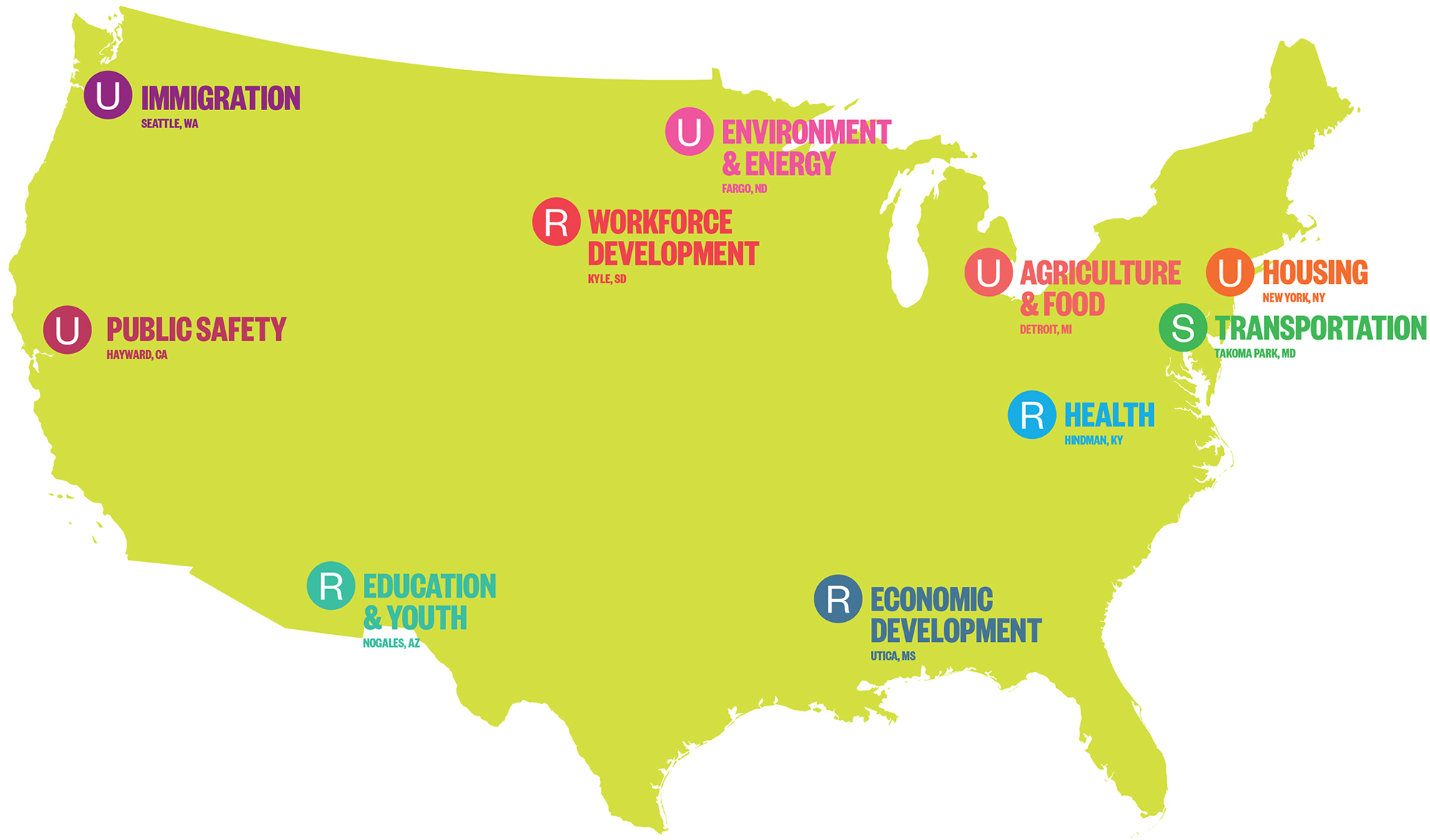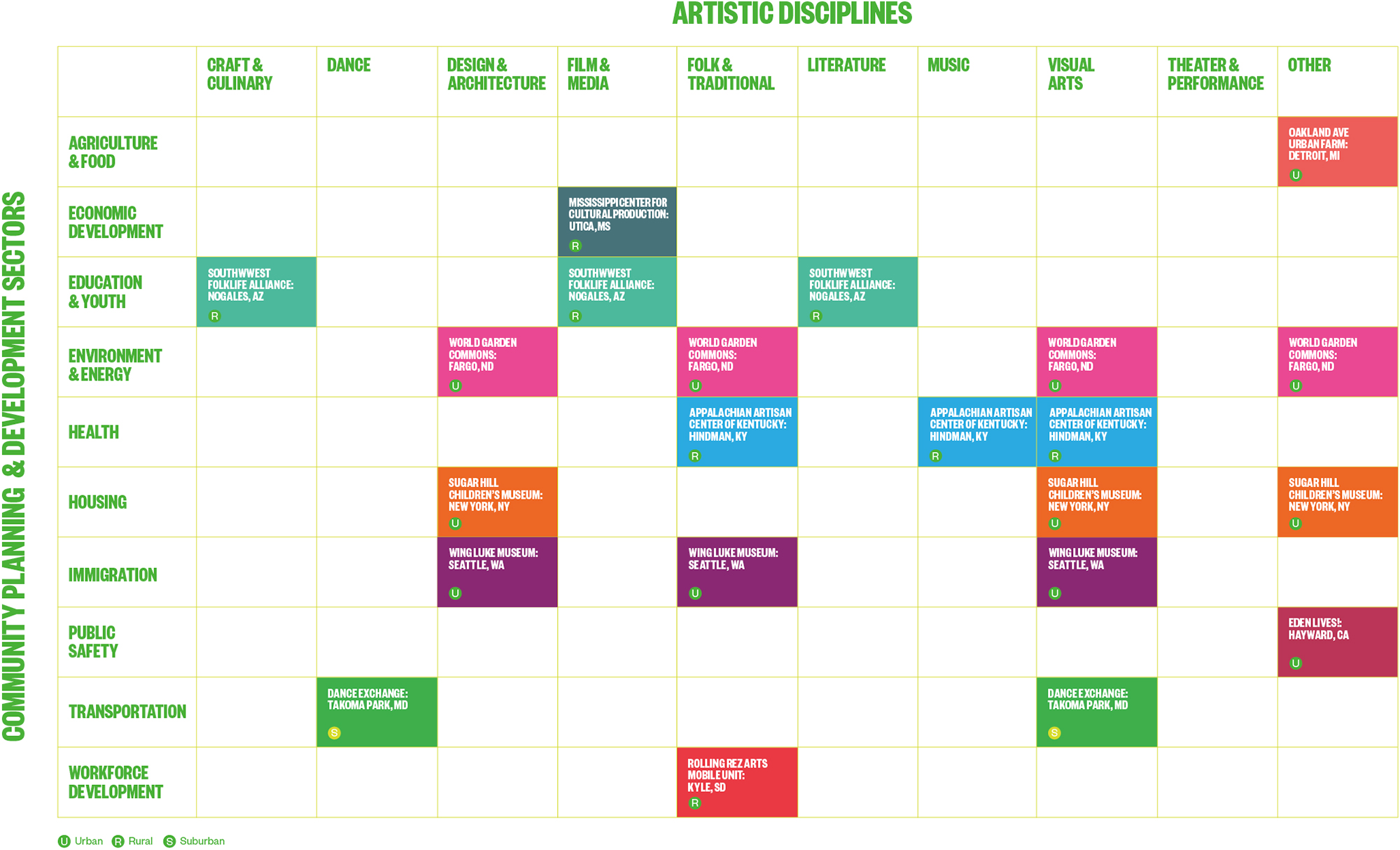10 SECTORS 10 SOLUTIONS
Artists and Community Change
Artists can be powerful influencers because art can cross boundaries and ideological barriers.
— Kate Wolford
INTRODUCTION
Creative placemaking happens when artists and arts organizations join their neighbors in shaping their community’s future — working together to produce beneficial, place-based outcomes. This practice is at its best when it is locally defined and informed and centers the people who live, work, and play in a place. The term “creative placemaking” was introduced to American communities in 2010 through a white paper authored by Ann Markusen and Anne Gadwa Nicodemus and commissioned by the National Endowment for the Arts. While artists’ involvement in cultivating communities stretches back to the earliest civilizations around the world, this paper summarized two decades of creative placemaking in the United States, with an emphasis on the role of the arts in livability and economic development. Over time, practitioners of creative placemaking have increasingly pushed the boundaries of traditional community planning and development and have demonstrated the effectiveness of building creative, cross-sector, interdisciplinary solutions to local challenges. Today, as the field of creative placemaking rapidly grows in rural, Tribal, suburban, and urban communities across the United States, the conversation has grown to encompass many other ways arts and culture can address community planning and development issues. The people and organizations who do this work are also more diverse than ever: they operate across sectors, strive to achieve a range of human-centered outcomes, and include everyone from artists to residents to teachers to professional community planners. Creative placemaking does not necessarily seek to make places more “creative” — instead, it empowers artists and their neighbors to creatively address local challenges and opportunities. Success in creative placemaking can be measured by the ways artists, formal and informal arts spaces, and creative interventions contribute to sustainable beneficial outcomes for communities. To support and advance this way of working, ArtPlace America (ArtPlace) was established by the National Endowment for the Arts as a collaboration among a number of foundations, federal agencies, and financial institutions to position arts and culture as a core sector of community planning and development. Much of the work of community planning and development can be organized into 10 core sectors:
AGRICULTURE & FOOD ECONOMIC DEVELOPMENT EDUCATION & YOUTH ENVIRONMENT & ENERGY HEALTH HOUSING IMMIGRATION PUBLIC SAFETY TRANSPORTATION WORKFORCE DEVELOPMENT
Inherent in each of these 10 sectors are specific goals and desired outcomes, and a particular set of strategies and tactics to achieve them. By exploring how arts and culture can contribute to positive place-based outcomes in each of these sectors, ArtPlace aims to develop open processes, shared languages, and common aspirations. The goal in this work is that communities continue to benefit from the powerful, cross-sector synergies generated by today’s creative placemaking practitioners.
This exhibition features 10 creative placemaking projects supported by ArtPlace America. Each of the projects works with a different sector of community planning and development. This map demonstrates the geographic diversity represented in the exhibition, and also shows community types: Urban (U), Rural (R), and Suburban (S).
This matrix shows the different Community Planning & Development Sectors each project is working with, along with Artistic Disciplines engaged.
When you share an arts experience with someone you can both maintain your unique cultural identity and share a bond.
— Jamie Bennett
EXHIBITION OVERVIEW
Many traditional planning and development efforts have fallen short of delivering equitable, healthy, sustainable outcomes in communities. In response, artists and arts organizations across the United States are developing the kinds of human-centered, contextual, adaptive solutions that can strengthen their communities from within. This exhibition highlights 10 creative placemaking projects from across the country, each supported by ArtPlace America, each addressing a community need, and each working within a traditional community planning and development sector: Agriculture & Food, Economic Development, Education & Youth, Environment & Energy, Health, Housing, Immigration, Public Safety, Transportation, and Workforce Development.
ORGANIZERS
This open source exhibition is organized by ArtPlace America and presented by galleries across the United States.
CURATOR
Adam Erickson, ArtPlace America
EXHIBITION AND WEBSITE DESIGN
Manuel Miranda Practice
ABOUT ARTPLACE AMERICA
ArtPlace America (ArtPlace) is a 10-year collaboration among a number of foundations, federal agencies, and financial institutions. Beginning work as an organization in 2011, and finishing in 2020, its mission is to position arts and culture as a core sector of community planning and development.
ABOUT MANUEL MIRANDA PRACTICE
Manuel Miranda Practice (MMP) uses graphic design to make places and content visible, legible, and navigable to people. In addition to studio practice, Manuel Miranda is a critic at the Yale School of Art and a member of New York City’s Public Design Commission. MMP is based in the Lower East Side of New York City.
GALLERY PARTNERS
This exhibition originated in the fall of 2018 in partnership with Ronit Eisenbach and the Kibel Gallery at the University of Maryland (College Park, MD). Other gallery partners include the Indigenous Design + Planning Institute at the University of New Mexico (Albuquerque, NM), The Arts Center of Mississippi (Jackson, MS), the Cincinnati Center for Architecture + Design (Cincinnati, OH), and the Center for Architecture and Design (Philadelphia, PA). Learn more about hosting the exhibition in your space.
The arts help people realize ‘I can’ — they are an antidote for disempowerment.


